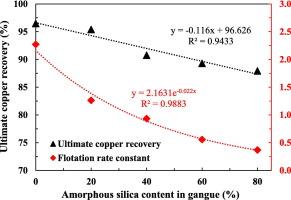Amorphous silica effects on copper flotation: A kinetic and selectivity investigation
IF 4.5
2区 工程技术
Q2 ENGINEERING, CHEMICAL
引用次数: 0
Abstract
Amorphous silica has been recently recognized for its adverse effects on copper flotation, but its impact remains poorly understood. This study investigates the effects of varying amorphous silica content on the kinetics and selectivity of copper flotation. Results show a significant reduction in chalcopyrite from approximately 99 % to 86 % with increasing amorphous silica content, attributed to increased pulp viscosity and slowed flotation kinetics. The classical first-order kinetic model provided the best fit for the flotation kinetics data, revealing that higher amorphous silica content prolongs the time required to achieve ultimate recovery. Results also show that amorphous silica deteriorated flotation selectivity and increased gangue recovery via entrainment, with complex variations depending on amorphous silica content. A small amount of amorphous silica was identified to significantly impair flotation kinetics and selectivity, leading to a deterioration in overall flotation performance.

无定形二氧化硅对铜浮选的影响:动力学和选择性研究
无定形二氧化硅近来被认为对铜浮选有不利影响,但人们对其影响仍知之甚少。本研究调查了不同无定形二氧化硅含量对铜浮选动力学和选择性的影响。结果表明,随着无定形二氧化硅含量的增加,黄铜矿的含量从约 99% 显著下降到 86%,这归因于矿浆粘度的增加和浮选动力学的减慢。经典的一阶动力学模型最适合浮选动力学数据,表明无定形二氧化硅含量越高,实现最终回收所需的时间越长。研究结果还表明,无定形二氧化硅会降低浮选选择性,并通过夹带增加矸石回收率,其复杂变化取决于无定形二氧化硅的含量。少量的无定形二氧化硅会严重影响浮选动力学和选择性,导致整体浮选性能下降。
本文章由计算机程序翻译,如有差异,请以英文原文为准。
求助全文
约1分钟内获得全文
求助全文
来源期刊

Powder Technology
工程技术-工程:化工
CiteScore
9.90
自引率
15.40%
发文量
1047
审稿时长
46 days
期刊介绍:
Powder Technology is an International Journal on the Science and Technology of Wet and Dry Particulate Systems. Powder Technology publishes papers on all aspects of the formation of particles and their characterisation and on the study of systems containing particulate solids. No limitation is imposed on the size of the particles, which may range from nanometre scale, as in pigments or aerosols, to that of mined or quarried materials. The following list of topics is not intended to be comprehensive, but rather to indicate typical subjects which fall within the scope of the journal's interests:
Formation and synthesis of particles by precipitation and other methods.
Modification of particles by agglomeration, coating, comminution and attrition.
Characterisation of the size, shape, surface area, pore structure and strength of particles and agglomerates (including the origins and effects of inter particle forces).
Packing, failure, flow and permeability of assemblies of particles.
Particle-particle interactions and suspension rheology.
Handling and processing operations such as slurry flow, fluidization, pneumatic conveying.
Interactions between particles and their environment, including delivery of particulate products to the body.
Applications of particle technology in production of pharmaceuticals, chemicals, foods, pigments, structural, and functional materials and in environmental and energy related matters.
For materials-oriented contributions we are looking for articles revealing the effect of particle/powder characteristics (size, morphology and composition, in that order) on material performance or functionality and, ideally, comparison to any industrial standard.
 求助内容:
求助内容: 应助结果提醒方式:
应助结果提醒方式:


